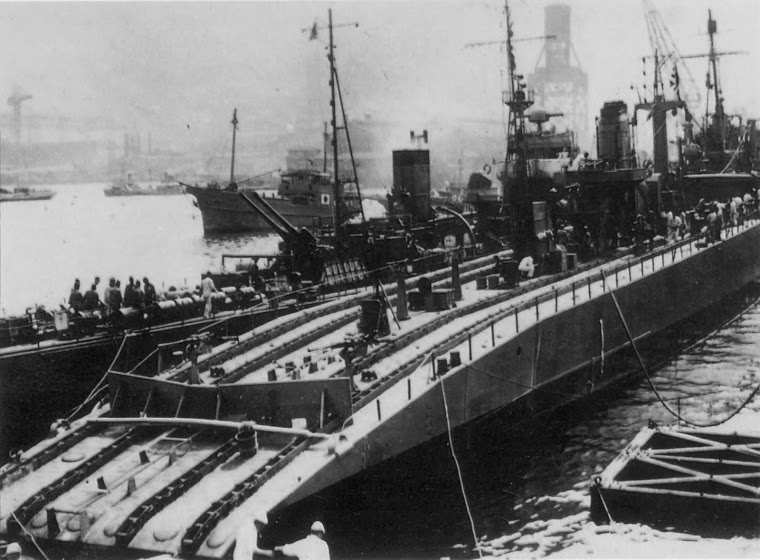
T.1-class Fast Transports
 (Fast Transport T. 9 under construction at
Kure)
(Fast Transport T. 9 under construction at
Kure)
In 1942 and 1943 during the fighting on Guadalcanal and the Solomons, large,
slow transports and destroyers converted to high-speed transports were unable to
carry and land sufficient quantities of troop and supplies needed to sustain
protracted combat operations in the face of American air superiority.
In April 1943, the IJN General Staff submitted a requirement to the IJN
Technical Department for new, purpose-built fast amphibious assault transports
capable of carrying and rapidly landing troops, cargo, Daihatsu landing craft or
Type 2 Ka-Mi amphibious tanks.
The IJN Technical Department responded with designs for the new T.1-class
fast naval transports that could be constructed using mass production techniques
such as pre-fabricated parts and electric welding. The T.1-class transports
were based on Matsu-class destroyer hulls with one set of engines removed to
make space for troops and cargo. At 22 knots, the resulting 1,500-ton vessel was
quite fast for an assault transport. The T.1-class design featured a distinctive
stern equipped with rollers and sloped down to the waterline. The T.1-class was
capable of rapidly launching landing craft. One 13- ton and four 5-ton derricks
were fitted to move cargo.
Later, the design was amended to permit the T.1-class to carry 46-ton
Type A “Ko-Hyoteki” and 59.6-ton Type D “Koryu” midget submarines and kaiten
human torpedoes and Shinyo
explosive motorboats (EMB). The class were equipped with AA guns, depth
charges, radar and sonar. During the war, the heavily-armed T.1-class fast transports were also used as minelayers and as escorts.
In October, 1943, 46 units of the T.1-class were ordered. Fifteen were
built at Kure Naval Arsenal and six at Mitsubishi Heavy Industries Most of
Kure's vessels were completed within 80 days after their keels were laid. T.22
was launched on 25 April 1945, but work was stopped on 23 June 1945 when 80~90
percent complete and scrapped in June 1948. In May 1945, the remaining 24
T.1-class units were canceled.
This page will cover all 21 units of the T.1-class. The war-time careers of the T.1a are generally relatively shorter than many other warship types covered in our TROMs. In at least one case, the T.1-class unit survived for less than a month after completion.
|
|
Builders and
Years Completed: |
Kure Naval Arsenal and Mitsubishi Heavy
Industries, Yokosuka
1943-1945 |
| Displacement: |
1,500-tons standard. |
| Dimensions: |
315' (LOA) x 33.1' x 11.75' |
| Propulsion: |
1 × Kampon geared turbine, 2 × Kampon water tube
boilers, single shaft, 9,500 shp, speed 22 knots |
| Armament: |
1 x twin 12.7 cm/40 Type 89 dual purpose AA gun; 3 x triple 25 mm/60 Type 96 AA machine cannons; 1 x twin, 25 mm/60 Type 96 AA machine
cannon; 4 x single (15 x 1 from Sep '44) 25 mm/60 Type 96 AA machine cannons; 5 x single 13 mm/76 Type 93 machine guns (Sep '44); 18 depth charges (42 from May
'44); 4 DCT (from May '44)
|
| Equipment: |
Radar: 1 x Type 22; 1 x Type 13 (Feb '45)
Sonar:
1 x Type 93 sonar, 1 to 4 x Type 93 hydrophones
Cargo Capacity: 4 ×
Daihatsu and 260 tons freight or 7 × Type 2 Ka-Mi tanks and 220 tons freight or
2 × Ko-hyouteki midget submarines and 184 tons freight or 6 × Kaiten human
torpedoes or Kairyu midget submarines and 243 tons freight
| |
|






